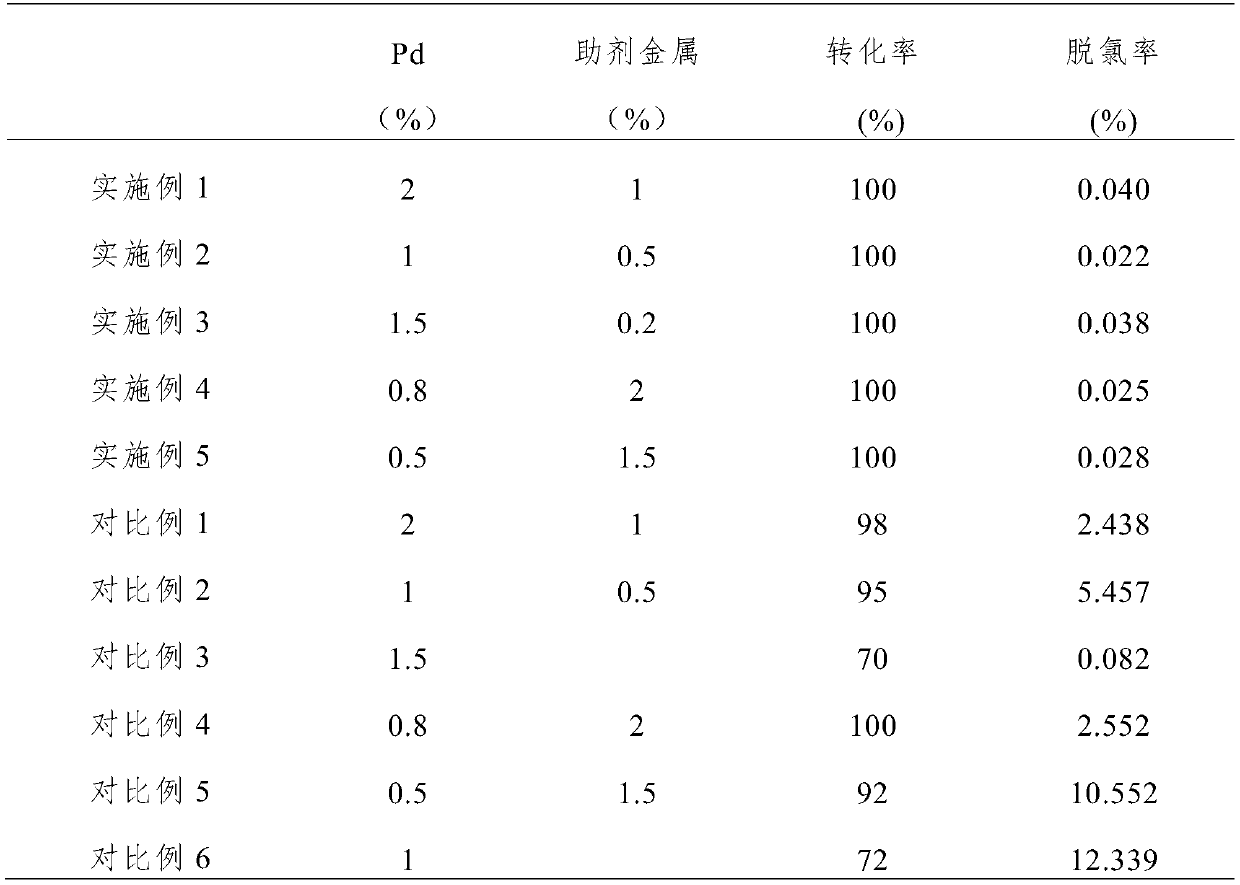Catalyst for synthesizing 3, 5-dichloroaniline, and preparation method and application of catalyst
A dichloroaniline and catalyst technology, applied in the field of catalysts for the synthesis of 3,5-dichloroaniline and its preparation, can solve the problems of serious environmental pollution, reduced reaction rate, and difficult handling, and achieve high catalytic reaction selectivity and adsorption Strong ability and high catalytic activity
- Summary
- Abstract
- Description
- Claims
- Application Information
AI Technical Summary
Problems solved by technology
Method used
Image
Examples
Embodiment 1
[0030] The catalyst for the synthesis of 3,5-dichloroaniline in this embodiment includes a barium sulfate carrier, Pd and promoter metals loaded on the barium sulfate carrier, and in the catalyst, the mass percentage of Pd is 2.0%. The mass percentage of the auxiliary metal is 1.0%, and the auxiliary metal is Mn.
[0031] The preparation method of the catalyst for the synthesis of 3,5-dichloroaniline of the present embodiment comprises the following steps:
[0032] Step 1. Add 50g of barium sulfate carrier to 500mL of boric acid solution with a mass percentage of 2%, stir and reflux in a water bath at 80°C for 3h, filter, wash the retentate, and place the retentate after washing in an oven at 100°C for vacuum drying After 24 hours, add it to 250 mL of 5% sodium phosphite solution by mass, stir at room temperature for 24 hours, filter, wash, and vacuum-dry in an oven at 100°C for 24 hours to obtain pretreated barium sulfate;
[0033] Step 2, mixing the pretreated barium sulfat...
Embodiment 2
[0036]The catalyst for the synthesis of 3,5-dichloroaniline in this embodiment includes a barium sulfate carrier, Pd and promoter metals loaded on the barium sulfate carrier, and in the catalyst, the mass percentage of Pd is 1.0%. The mass percentage of the auxiliary metal is 0.5%, and the auxiliary metal is Co.
[0037] The preparation method of the catalyst for the synthesis of 3,5-dichloroaniline of the present embodiment comprises the following steps:
[0038] Step 1. Add 50g of barium sulfate carrier to 500mL of boric acid solution with a mass percentage of 15%, stir and reflux in a water bath at 100°C for 5h, filter, wash the retentate, and place the retentate after washing in an oven at 100°C for vacuum drying After 24 hours, add it to 250 mL of 10% sodium phosphite solution by mass, stir at room temperature for 20 hours, filter, wash, and vacuum-dry in an oven at 100°C for 24 hours to obtain pretreated barium sulfate;
[0039] Step 2, mixing the pretreated barium sulf...
Embodiment 3
[0042] The catalyst for the synthesis of 3,5-dichloroaniline in this embodiment includes a barium sulfate carrier, Pd and promoter metals loaded on the barium sulfate carrier, and in the catalyst, the mass percentage of Pd is 1.5%. The mass percentage of the auxiliary metal is 0.2%, and the auxiliary metal is Cu.
[0043] The preparation method of the catalyst for the synthesis of 3,5-dichloroaniline of the present embodiment comprises the following steps:
[0044] Step 1. Add 50g of barium sulfate carrier to 500mL of boric acid solution with a mass percentage of 25%, stir and reflux in a water bath at 100°C for 5h, filter, wash the retentate, and place the retentate after washing in an oven at 100°C for vacuum drying After 24 hours, add it to 250 mL of 20% sodium phosphite solution by mass, stir at room temperature for 20 hours, filter, wash, and vacuum-dry in an oven at 100°C for 24 hours to obtain pretreated barium sulfate;
[0045] Step 2, mixing the pretreated barium sul...
PUM
 Login to View More
Login to View More Abstract
Description
Claims
Application Information
 Login to View More
Login to View More - R&D Engineer
- R&D Manager
- IP Professional
- Industry Leading Data Capabilities
- Powerful AI technology
- Patent DNA Extraction
Browse by: Latest US Patents, China's latest patents, Technical Efficacy Thesaurus, Application Domain, Technology Topic, Popular Technical Reports.
© 2024 PatSnap. All rights reserved.Legal|Privacy policy|Modern Slavery Act Transparency Statement|Sitemap|About US| Contact US: help@patsnap.com








